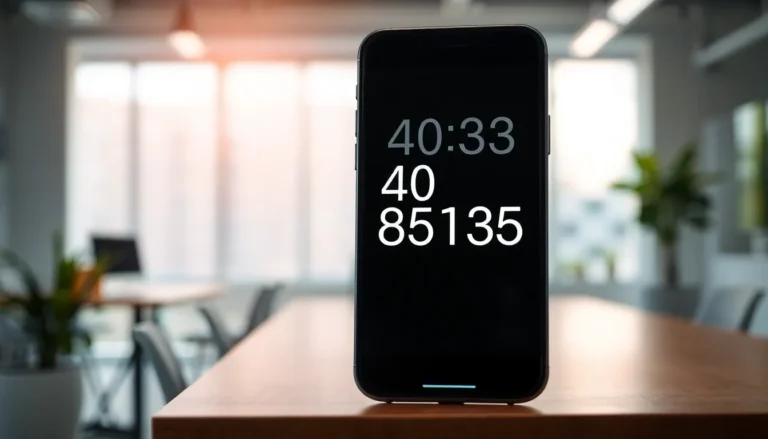In a world where time is money and every second counts, waiting for an iPhone to charge can feel like watching paint dry. If you’ve ever found yourself staring at that little battery icon, you know the struggle is real. But fear not! Fast charging is here to save the day, and knowing if your iPhone is taking advantage of this magic can make all the difference.
Table of Contents
ToggleUnderstanding Fast Charging
Fast charging significantly reduces the time needed to power up an iPhone. Recognizing this feature helps users maximize efficiency during charging.
What Is Fast Charging?
Fast charging refers to a technology enabling devices to charge at higher wattages. It utilizes compatible chargers and cables to deliver increased energy to the battery. iPhones, starting with the iPhone 8, support this feature. Using a USB-C to Lightning cable with a power adapter rated at 18 watts or higher activates fast charging. This method allows for up to 50% battery charge in around 30 minutes.
Benefits of Fast Charging
Fast charging offers several advantages for iPhone users. Firstly, it saves time, allowing for quicker recharges between uses. Secondly, it enhances convenience for those with busy schedules, as users can briefly charge their devices during coffee breaks or commutes. Third, it provides flexibility in charging, whether at home, the office, or on the go. Additionally, fast charging maintains the battery’s long-term health when done correctly, without compromising safety.
Signs Your iPhone Is Fast Charging
Recognizing when an iPhone is fast charging enhances the efficiency of the charging process. Several indicators confirm the phone is utilizing this feature.
Charging Icon Indicators
Look for the lightning bolt symbol next to the battery icon in the upper right corner of the screen. This symbol indicates an active fast charging scenario. The charging screen may also display messages like “Charging” or “Fast Charging” when applicable. An absence of these indicators could suggest the iPhone is charging at a standard rate. Additionally, if the device shows a battery symbol in a circle, it confirms that fast charging is in effect.
Battery Percentage Increase
Notable increases in battery percentage during charging signals that fast charging is active. For instance, users often observe a jump from 0% to 50% within about 30 minutes when using a compatible charger. A momentary pause or slower percentage rise might imply standard charging instead. Monitoring battery increments every few minutes provides a clear snapshot of charging efficiency. If the percentage rises swiftly, the iPhone is indeed fast charging.
Required Accessories for Fast Charging
Fast charging requires specific accessories to function effectively. Utilizing compatible chargers and suitable cables ensures optimal charging speed.
Compatible Chargers
Chargers must meet certain power requirements for fast charging. Apple’s 18-watt or higher USB-C power adapter enables this feature. Third-party chargers can also work but must support USB Power Delivery (USB-PD) standards to maintain efficiency. Users should always check that the charger provides sufficient wattage for their iPhone model. For example, chargers above 20 watts can charge newer models even faster, allowing quick power boosts when needed.
Suitable Cables
Cables also play a crucial role in fast charging. A USB-C to Lightning cable is necessary for enabling this function. Apple’s official cables guarantee reliable performance and safety standards. However, MFi-certified third-party cables can also provide effective connectivity. Users should avoid generic cables, as these might not support the required charging speeds. Maintaining high-quality cables enhances the fast charging experience significantly.
Troubleshooting Fast Charging Issues
Identifying fast charging problems can enhance the charging experience. Some users encounter specific challenges that may hinder the effectiveness of fast charging.
Common Problems
Incompatibility of chargers often leads to slow charging issues. Older or non-certified adapters might not provide the necessary wattage. Cables can also pose problems; damaged or non-MFi certified cables may fail to support fast charging capabilities. Software glitches sometimes prevent accurate battery percentage readings. Additionally, using the iPhone while charging can reduce efficiency, as background processes consume power during the charging cycle.
Solutions and Tips
To maintain optimal charging speeds, using the correct charger is essential. Ensure the charger provides at least 18 watts. Checking the cable for compatibility and wear can prevent issues; opting for MFi certified accessories is advisable. Restarting the iPhone may resolve any temporary software glitches. Limiting usage while charging will enhance faster battery uptake. Monitoring the charging indicators can provide real-time feedback on charging status, ensuring users effectively utilize fast charging features.
Understanding how to identify fast charging on an iPhone can transform the charging experience. By recognizing key indicators like the lightning bolt symbol and monitoring battery percentage increases users can ensure they’re maximizing the benefits of fast charging. Using the right accessories is crucial for achieving optimal speeds and maintaining battery health.
For those who often find themselves pressed for time fast charging offers a practical solution to keep devices powered up quickly. Staying aware of potential troubleshooting tips can further enhance the effectiveness of this feature. With the right knowledge and tools users can enjoy a more efficient charging experience.


